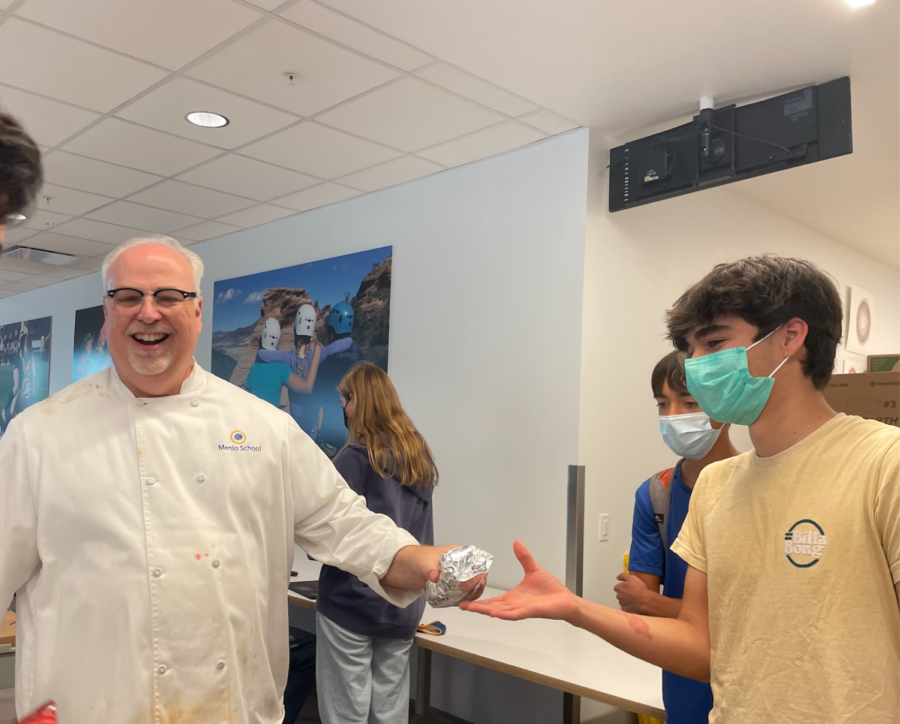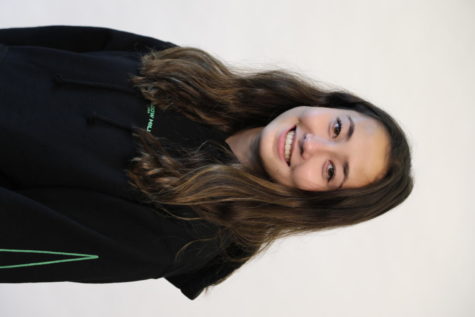When Will the Cafeteria Reopen?
Menlo students pick up their pre-packaged lunches from inside the cafeteria. According to Hoang, if COVID-19 testing in the near future proves that the community is healthy, the cafeteria will open up its hot lunch lines, too. Staff Photo: Kaylie Wu.
September 21, 2021
Due to COVID-19 restrictions, Menlo School’s cafeteria has been unavailable to students since March 2020. When the campus reopened in October 2021, boxed lunches replaced cafeteria meals, and the kitchen staff still serves them today. Before the cafeteria can become available to students again, the community must make several changes, according to Menlo Director of Dining Services Thien Hoang.
The dining hall will not reopen all at once. Instead, the cafeteria’s features will become available over time. First, the staff is focused on restarting its hot lunches within the next few weeks, which are served from the two main windows inside the cafeteria. These windows would include pizzas — which were available daily before the pandemic — as well as other meals that could not be well-kept inside boxes. “We’ll be able to make the stuff that wasn’t going to taste good in a box, such as chicken fingers and french fries,” Hoang said.
According to Hoang, when hot lunch lines reopen indoors, students will have more meal options. For example, on the day hamburgers are served, students can decide if they want lettuce, tomatoes and onions. Students currently don’t have this freedom because the cafeteria staff must make all boxed lunches the same way. Further adding to these choices, condiment stations would be accessible inside the cafeteria once again. Students could choose ketchup and mustard for their burgers, or salsa and sour cream for their tacos.
For the cafeteria’s hot food lines to successfully restart, Menlo must take a few preventive measures. On Monday, Sept. 13, Polymerase Chain Reaction testing for COVID-19 resumed in the Spieker Center.
The cafeteria status also depends on vaccination rates. According to Hoang, when more people in the Menlo community are vaccinated, more restrictions can be lifted. Many sixth and seventh graders are still ineligible to receive the vaccine, so Menlo must keep unvaccinated middle schoolers somewhat isolated when the cafeteria’s indoor seating becomes available.
However, if the vaccine does become accessible to children under 12, operating the cafeteria would not only be much easier, but also much safer. “If everything goes as planned, and the kids under 12 are vaccinated, then hopefully by the time 2022 comes around we’ll be able to open up the dining hall room, just like we had before we closed out for COVID-19,” Hoang said. This would include self-serve options, like the sandwich and salad bars. Colder seasons are approaching, so it would also be much more convenient for students to eat inside, sheltered from unpleasant weather, Hoang explained.
Apart from safety, Menlo’s cafeteria may also need to increase its staff before reopening. Right now, six people work in Menlo’s dining services. According to Hoang, there were twice as many staff members prior to the pandemic. If the cafeteria reverts to its pre-COVID-19 state, the number of cafeteria workers may need to do the same.
Until the cafeteria is able to reopen, Hoang and other cafeteria workers want to improve students’ dining experiences, but boxed lunches generate many restrictions. Originally, Hoang experimented with serving popular hot meals, such as grilled cheese, in boxes. “We tried to do grilled cheeses, but they were soggy and hard,” Hoang said. “We tried quesadillas, and we tried chicken parm. When you put food into a box and don’t eat it within five to ten minutes, it’s not going to be good.”
A few hot lunches have been successful in boxes, including sweet and sour chicken, but options are still extremely confined. Despite these limitations, Flik produces around 925 boxed meals a day, and almost 450 are hot lunches. Additionally, desserts are served daily in boxed lunches, whereas desserts were only served two to three times a week in the cafeteria before COVID-19. “We’re trying to give you guys that little special thing, because [lunch] is so limited now,” Hoang said.



